Welcome to Dakar! A city where the Atlantic Ocean meets a tapestry of cultures, vibrant street art, and a history as rich and complex as its diverse neighborhoods. This bustling capital of Senegal is a symphony of sounds, from the bustling markets to the rhythm of Mbalax music echoing through the streets. Embark on a journey to Dakar, and you’re signing up for an adventure that will tantalize your senses, challenge your perceptions, and immerse you in an energy that’s uniquely West African.
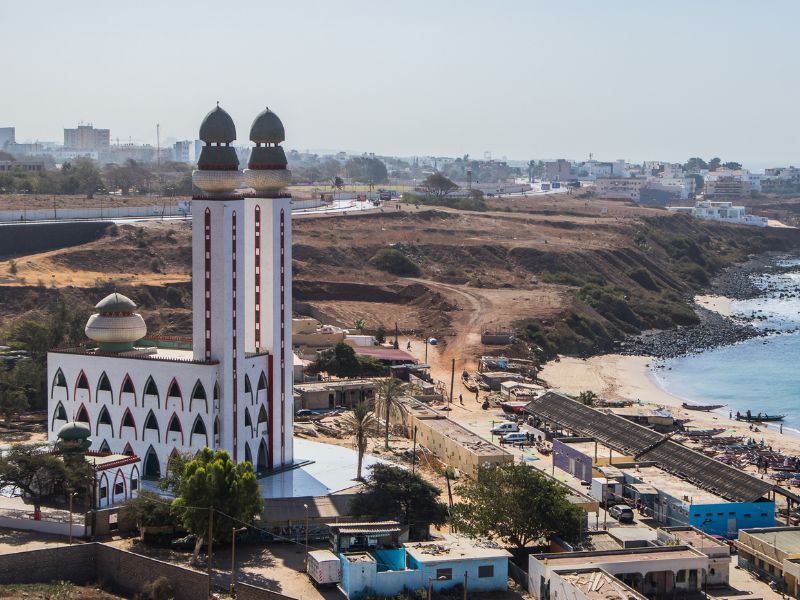
The Heartbeat of Senegal
Dakar stands as a beacon of African vibrancy and resilience, a city that pulsates with life at every corner. From the historic Île de Gorée, whispering stories of the past, to the bustling markets like Sandaga, where every stall tells a tale. It’s a city of contrasts, where traditional meets contemporary and the sea breezes blend with urban hustle.
A Culinary Melting Pot
Prepare your taste buds for a journey through Dakar’s culinary landscape, a flavorful fusion of French, North African, and local Senegalese cuisine. Whether it’s sampling Thieboudienne at a local ‘dibiterie’ or savoring fresh seafood by the coast, Dakar offers a feast for the senses. The city’s food is a testament to its multicultural heartbeat, inviting you to taste its history and diversity in every bite.
An Artistic and Musical Odyssey
Dakar’s soul shines brightly through its art and music. Wander through neighborhoods adorned with street art, visit galleries showcasing contemporary African artists, and end your day swaying to the rhythms of live music in the city’s lively clubs. This is a place where creativity is the currency, and the city’s artistic scene is as dynamic and varied as its people.
Natural Wonders and Outdoor Adventures
Beyond the city’s lively streets lies a world of natural beauty waiting to be explored. Take a trip to the serene Lac Rose, float in its pink waters, or explore the rugged beauty of the Senegalese coastline, offering surfers and sun-seekers alike a perfect escape. Dakar is a gateway to outdoor adventures that highlight the stunning landscapes of West Africa.
So pack your bags, bring an open heart, and get ready to be swept up in the rhythm of Dakar.

Dakar City Guide: A Brief History Of Dakar, Senegal
Dakar carries with it a history as colorful and diverse as the fabrics sold in its bustling markets. This city, now pulsating with the beat of Mbalax music and adorned with graffiti art, has a story that stretches back through centuries of change, resilience, and cultural fusion. Let’s peel back the layers of this dynamic city to uncover the roots that ground Dakar’s spirited presence.
From Lebou Fishermen to French Colonial Hub
The story of Dakar begins with the Lebou, an ethnic group primarily known for their fishing prowess, who originally settled the Cap-Vert Peninsula. Fast forward to the mid-15th century, and Portuguese explorers set their sights on this strategic point, marking the start of European interest. However, it was the French who left an indelible mark, establishing Dakar as a major port and the capital of French West Africa. This colonial chapter layered Dakar’s history with European influences, visible in its architecture and urban planning.
The Gateway to Africa
Dakar’s strategic location on the westernmost tip of Africa made it a pivotal gateway between Africa and Europe. It flourished as a center for trade, cultural exchange, and later, as a crucial point in the transatlantic slave trade. The infamous House of Slaves on Gorée Island, a poignant reminder of this dark era, stands as a testament to resilience and the fight for freedom. Today, Gorée Island is a UNESCO World Heritage site, drawing visitors from around the world to reflect on history’s shadows and the light of human endurance.
Independence and Growth
The mid-20th century brought winds of change across Africa, with Dakar at the forefront of Senegal’s quest for independence. Achieved in 1960, with Léopold Sédar Senghor, one of Africa’s most revered poets and thinkers, becoming the country’s first president, Dakar began shaping its identity as a modern African metropolis. The city burgeoned as a center for African politics, culture, and intellect, hosting the influential First World Festival of Negro Arts in 1966, which showcased the richness of African culture to the world.
Dakar Today: A Cosmopolitan Beacon
Dakar’s narrative continues to evolve, with the city now standing as a symbol of Africa’s dynamism, creativity, and future potential. It’s a place where traditional wrestling matches captivate local audiences, contemporary art galleries thrive, and music fills the air, from hip-hop to traditional Sabar drums. The city’s universities and institutions are nurturing the next generation of African leaders, thinkers, and artists.
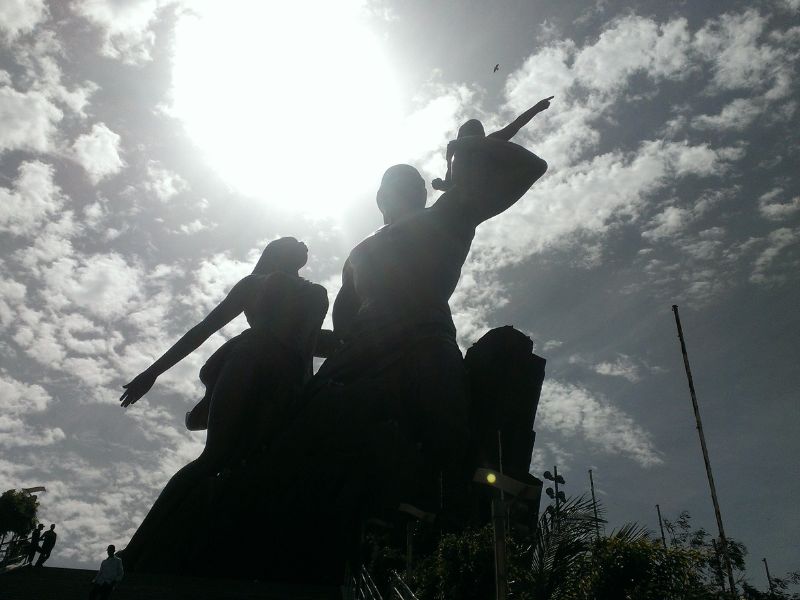
Dakar Top Attractions and Best Places to Visit in Senegal
Sitting on a spit of land that constitutes Africa’s westernmost point, Dakar is one of the most important cities in the region. Its geographic position put it in the centre of the slave trade, but today, it is better known for its culture, surfing, and an unusually pink lake.
More than just a transit point for those looking to explore the Senegalese countryside, Dakar is worth at least a couple days of solid exploration.
After arriving in Dakar, take a boat trip to Gorée Island to visit the ominously-named House of Slaves. As you might expect, this facility was where captured Africans were held before being shipped off across the Atlantic to colonies run by the major European powers during the Age of Exploration.
When one takes the guided tour on site, you will be led into dark dungeon-like chambers where countless hundreds of prisoners were sandwiched together before being led through the Door of No Return, where ships waited to carry them off to a life of forced servitude.
The iron shackles used to restrain these poor human beings will have an enormous impact on anyone with a soul, just as it did with Barack Obama and Nelson Mandela, the latter of whom excused himself to process what he had seen in silence.
More Attractions
After this heavy visit, lighten things up a bit by making the IFAN Museum of African Arts your next stop. Ranking as one of the oldest art museums in Western Africa, it was founded by French colonial authorities in 1936, and was transferred to the care of Cheikh Anta Diop University in 1960.
Today, it features the best creative works produced by artists in Senegal and West Africa, as well as a wide variety of cultural artifacts sourced from across French colonial Africa (places that are now nations like Guinea Bissau, Cote D’ Ivoire, etc).
While the best works in Senegal usually find their way into the halls of IFAN, Village des Arts is the best place to go in Dakar if you want to see them being made. Here, you’ll find creatives crafting their latest pieces, and selling items they have made recently.
As such, this is the best place to go if you wish to converse with these talented individuals, and if you want to take an authentic piece home, they will be more than willing to make a deal with you.
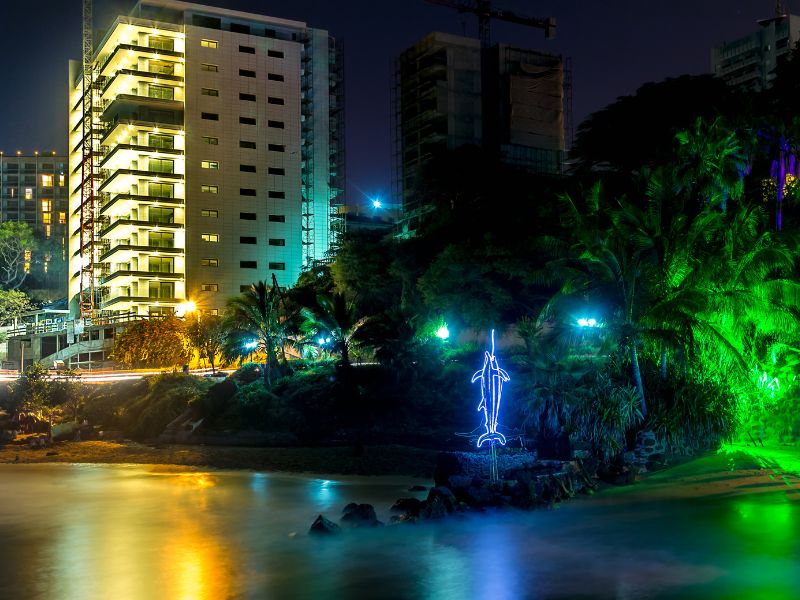
Other Cultural Attractions: Trip to Dakar, Senegal
As a nation, Senegal is little more than a half century old. In 2010, the African Renaissance Monument was unveiled to mark the occasion, and despite the controversy, it has attracted for its exorbitant price tag and the fact that a North Korean company was used for the project, it is still a sight to behold.
Standing more than 49 metres or 160 feet above its podium, and more imposing that it would otherwise be due to its position on a prominent hill, it can be seen through much of Dakar. However, the best pics can be had up close, so make the effort to travel out to its location if you can.
Other Attractions
Those looking to take a cool day trip from Dakar should check out Lago Rosa. A lake that boasts a perfect pink hue thanks to its abundant population of algae, you might think that taking a dip would be ill-advised.
However, not only is it safe to do so, but its excessive salinity gives it a buoyancy comparable to the Dead Sea. So long as you don’t expose your eyes to the water, a swim here will prove to be one of the better things you’ll do during your visit to the Dakar area.
Consider yourself to be an accomplished surfer? Head to Ngor Island, which sits just off the coast of Dakar. The side that faces the open Atlantic sees continual swells, many of which are epic in size.
For the less adventurous, the beaches on the sheltered side of Ngor are great for swimming and relaxing, and the nightlife that happens here will only make it that much harder to leave if you are on an extended journey through Africa.
source: Sky Travel on YouTube
Top 22 Things To Do in Dakar, Senegal For Visitors
Here’s a guide to the top 22 things to do in Dakar:
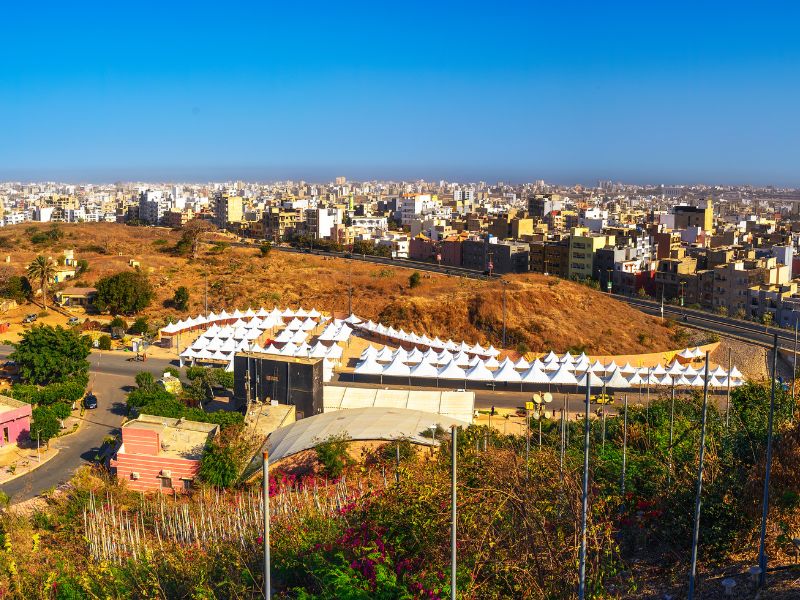
1. Visit the African Renaissance Monument
The African Renaissance Monument stands taller than the Statue of Liberty and symbolizes Africa’s strength and resurgence. This colossal bronze statue is an iconic sight, offering sweeping views of Dakar and the Atlantic Ocean from its base. Though its construction sparked controversy, the monument remains a significant cultural landmark. Visitors can stroll through the surrounding gardens for a peaceful break.
- Panoramic views: Enjoy stunning vistas of Dakar and the coastline.
- Symbol of strength: Represents Africa’s emergence from colonialism.
- Relaxing strolls: Well-kept gardens offer a serene environment.
2. Explore Île de Gorée
A short ferry ride from Dakar, Île de Gorée is a UNESCO World Heritage site known for its role in the Atlantic slave trade. The island offers a poignant glimpse into history with its preserved colonial architecture and the House of Slaves. Visitors can wander its quiet, car-free streets lined with colorful buildings. Museums, art galleries, and tranquil beaches make it an ideal day trip.
- UNESCO site: A sobering reminder of the slave trade.
- Historic charm: Explore colonial-era buildings and museums.
- Car-free streets: Perfect for peaceful exploration.
3. Shop at Marché Kermel
Marché Kermel is a vibrant market housed in a charming colonial-era building in the heart of Dakar. The market is famous for its fresh produce, seafood, and handcrafted goods. A sensory overload awaits as you navigate through colorful stalls selling spices, fabrics, and jewelry. It’s an ideal spot for bargaining and interacting with local vendors.
- Fresh goods: Find seafood, fruits, and vegetables.
- Crafts and souvenirs: Browse for handmade Senegalese items.
- Cultural immersion: Experience Dakar’s lively market scene.
4. Relax at Plage de N’Gor
A quick boat ride from Dakar will take you to N’Gor Beach, a popular escape for both locals and tourists. This peaceful island features multiple beaches, with some perfect for surfing and others for leisurely swimming. Beachfront cafes serve fresh seafood and cold drinks, creating a laid-back atmosphere. It’s the ideal spot to unwind and soak in the sun.
- Surfing: Great waves for beginners and pros.
- Seafood cafes: Enjoy fresh meals by the beach.
- Island escape: A quick, scenic boat ride from Dakar.
5. Visit the Museum of Black Civilizations
The Museum of Black Civilizations is a world-class institution that showcases African art, history, and culture. Exhibits span from prehistoric times to modern-day works, offering a comprehensive look at the continent’s heritage. The museum promotes a deeper understanding of African civilizations and their global influence. It’s a fascinating stop for anyone passionate about African history.
- Comprehensive exhibits: From ancient to modern African art.
- Cultural celebration: Highlights the diversity of African civilizations.
- Educational experience: Learn about Africa’s global impact.
6. Wander Around the Medina
The Medina of Dakar is a bustling, historic neighborhood full of narrow streets and lively markets. It’s home to the Grand Mosque of Dakar and countless artisans selling handmade crafts. Walking through the Medina offers a deep dive into local life, with vibrant street scenes at every turn. It’s a sensory experience where you can shop for unique souvenirs and soak in the culture.
- Vibrant markets: Find textiles, crafts, and more.
- Historic sights: Visit the Grand Mosque.
- Local life: Immerse yourself in Dakar’s daily rhythms.
7. Discover the IFAN Museum of African Arts
The IFAN Museum of African Arts is one of the oldest museums in West Africa, boasting a wide-ranging collection of traditional African art. It features artifacts like masks, sculptures, and musical instruments from across the continent. As a research center, the museum also plays a role in preserving and promoting African cultural heritage. It’s a must-see for anyone interested in African art.
- Art collection: Masks, sculptures, and instruments.
- Cultural heritage: Learn about West African traditions.
- Historic importance: One of the oldest art museums in Africa.
8. Enjoy the View from Les Mamelles Lighthouse
Climbing to the top of Les Mamelles Lighthouse provides some of the best panoramic views of Dakar and the surrounding ocean. Perched on one of Dakar’s twin hills, this lighthouse is a hidden gem for those seeking peace and natural beauty. The area around the lighthouse is also home to wildlife like hyraxes, adding to the charm of the visit. It’s a bit off the tourist trail but worth the trip.
- Scenic views: Overlook the ocean and Dakar.
- Wildlife spotting: Watch for local animals like hyraxes.
- Peaceful retreat: Escape the city for a tranquil visit.
9. Experience Dakar’s Nightlife
Dakar’s nightlife is famous for its lively mix of clubs, bars, and live music venues. The city pulses with energy after dark, offering everything from traditional Senegalese mbalax to international tunes. Venues like Just 4 U and Club Thiossane are hot spots for catching live performances by both local and international artists. If you want to dance the night away, Dakar is the place to be.
- Live music: Enjoy local and international performances.
- Diverse scene: From mbalax to modern beats.
- Nightlife hotspots: Dance at Just 4 U and Club Thiossane.
10. Surf at Ouakam Beach
Ouakam Beach is a surfer’s paradise, located near the impressive Mosque of Divinity. The beach offers waves for surfers of all levels, with surf schools and rental shops available for those new to the sport. After catching some waves, you can relax on the beach and take in the breathtaking views of the mosque perched on the cliffs. It’s the perfect combination of adventure and relaxation.
- Surf-friendly: Waves for all skill levels.
- Scenic backdrop: The Mosque of Divinity adds charm.
- Surf schools: Rentals and lessons available for beginners.
11. Visit Dakar’s Grand Mosque
The Grand Mosque of Dakar, completed in 1964, is an architectural and spiritual landmark. Its beautiful Moroccan-inspired design and tranquil atmosphere make it a must-see. Non-Muslims are welcome to visit outside of prayer times, providing a chance to admire the mosque’s interior and serene surroundings. The mosque is a central part of Dakar’s religious life and community.
- Moroccan architecture: Stunning tile work and design.
- Spiritual center: Plays a key role in the city’s religious life.
- Open to visitors: Explore the mosque outside of prayer times.
12. Stroll Along the Corniche
The Corniche is a beautiful coastal road that winds along Dakar’s cliffs and beaches, offering breathtaking views of the Atlantic Ocean. It’s perfect for a scenic walk, jog, or bike ride, with plenty of cafes and parks along the way. The route also passes by major landmarks like the African Renaissance Monument. The combination of ocean breezes and stunning vistas makes it a refreshing experience.
- Coastal beauty: Enjoy the stunning ocean views.
- Landmarks: Pass by the African Renaissance Monument.
- Relaxing stroll: Stop at cafes and parks along the way.
13. Explore the Village des Arts
The Village des Arts is a creative haven where over 50 Senegalese artists work and exhibit their creations. Visitors can explore studios showcasing painting, sculpture, and photography, and even meet the artists. The vibrant atmosphere highlights Senegal’s thriving art community. It’s the perfect place to purchase one-of-a-kind art pieces and support local talent.
- Creative hub: Explore studios of local artists.
- Meet the artists: Learn about their creative processes.
- Art for sale: Purchase unique, original artwork.
14. Indulge in Senegalese Cuisine
Dakar’s food scene is rich and varied, with traditional dishes like thieboudienne (fish and rice), yassa (marinated chicken or fish), and mafe (peanut stew). Local eateries and street food vendors provide an authentic taste of Senegal’s culinary delights. Fresh seafood is a staple, reflecting Dakar’s coastal location. Trying traditional Senegalese cuisine is a delicious way to connect with the culture.
- Local dishes: Taste thieboudienne, yassa, and more.
- Seafood: Enjoy fresh, local seafood at restaurants.
- Cultural connection: Eating with your hands is part of the tradition.
15. Take a Boat Trip to Les Madeleines
Les Madeleines are a group of uninhabited islands off the coast of Dakar, famous for their dramatic cliffs and diverse birdlife. A boat trip to the islands is a peaceful escape from the city, perfect for picnics and fishing. The islands are a protected nature reserve, ensuring their natural beauty remains untouched. It’s a serene destination for nature lovers and bird watchers.
- Nature reserve: Protected, pristine landscapes.
- Birdwatching: Spot a variety of seabirds.
- Picnics and fishing: Relax and enjoy the natural surroundings.
16. Attend the Dak’Art Biennale
The Dak’Art Biennale is one of Africa’s premier contemporary art events, showcasing the work of African artists and the African diaspora. Every two years, Dakar transforms into an art gallery, with exhibitions, performances, and installations throughout the city. The event promotes dialogue on contemporary issues and celebrates African creativity. It’s a fantastic time to explore Dakar’s cutting-edge art scene.
- Contemporary art: See work from African and diaspora artists.
- City-wide event: Exhibitions and installations throughout Dakar.
- Cultural exchange: Engage in conversations about modern African issues.
17. Visit the Sandaga Market
Sandaga Market is one of Dakar’s largest and busiest markets, offering everything from fresh produce to clothes and crafts. The chaotic energy of the market makes it an unforgettable experience. Bargaining is expected, so be prepared to haggle with vendors. It’s an ideal place to shop for souvenirs, spices, and textiles while experiencing local life up close.
- Vibrant atmosphere: Bustling with energy and activity.
- Bargaining: Haggle for the best prices.
- Souvenirs: Find textiles, crafts, and spices.
18. Relax at Saly Portudal
Saly Portudal is a beach resort area located south of Dakar, known for its beautiful white sand beaches and clear waters. It’s a popular getaway for both locals and tourists seeking relaxation and water activities. The resort town offers a range of accommodations, from luxury hotels to budget-friendly options. It’s a slice of paradise just outside Dakar’s hustle and bustle.
- Beach activities: Sunbathing, swimming, and water sports.
- Resort town: A mix of luxury and affordable options.
- Quick escape: Just a short drive from Dakar.
19. Explore the Bandia Nature Reserve
A safari experience awaits at the Bandia Nature Reserve, located a short drive from Dakar. Visitors can see African wildlife like giraffes, zebras, and rhinos in their natural habitat. Guided tours provide insight into the reserve’s conservation efforts and animal species. The reserve also features a restaurant where you can watch animals drink from a nearby watering hole.
- African wildlife: Spot giraffes, zebras, and more.
- Conservation: Learn about ongoing efforts to protect wildlife.
- Dining experience: Enjoy a meal while watching animals at the watering hole.
20. Visit the House of Slaves on Gorée Island
The House of Slaves on Île de Gorée is a moving memorial to the Atlantic slave trade. The museum provides a somber reflection on this dark chapter of history, with the Door of No Return serving as a symbol of the final exit point for enslaved Africans. It’s a deeply emotional visit that offers important historical context. The experience leaves a lasting impression on all who visit.
- Memorial site: A poignant reminder of the slave trade.
- Historic insight: Learn about the island’s role in the slave trade.
- Reflective visit: The Door of No Return is a powerful symbol.
21. Enjoy Senegalese Music and Dance
Music and dance are integral to Senegalese culture, with mbalax (a fusion of traditional rhythms and modern music) being the most popular genre. Dakar’s live music scene offers venues where you can enjoy performances by local artists. Traditional dance often accompanies the music, creating a lively and energetic atmosphere. Experiencing a live performance is a fantastic way to immerse yourself in Senegal’s vibrant culture.
- Live performances: Hear mbalax and other traditional music.
- Cultural immersion: Experience the rhythm and energy of Senegalese dance.
- Local venues: Visit popular spots like Just 4 U for live shows.
22. Participate in a Senegalese Cooking Class
Taking a Senegalese cooking class is an interactive and delicious way to learn about local cuisine. Many classes include a visit to a local market to source fresh ingredients before preparing traditional dishes like thieboudienne and yassa. You’ll gain insight into the techniques and flavors that define Senegalese cooking. Plus, you get to enjoy the meal you’ve prepared!
- Hands-on experience: Learn how to cook authentic Senegalese dishes.
- Market visit: Shop for fresh, local ingredients.
- Delicious reward: Enjoy the fruits of your labor at the end.
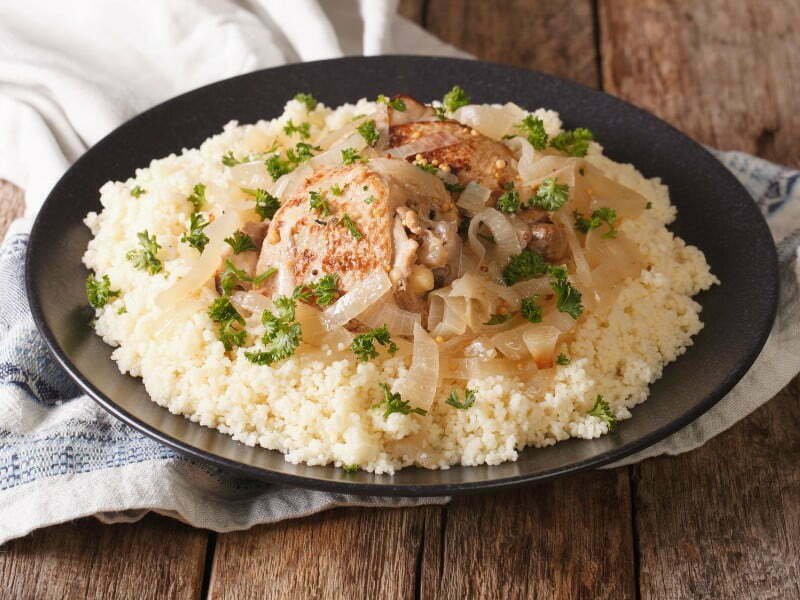
What To Eat and Drink in Dakar, Senegal
The Senegalese capital is a paradise for food lovers, where the richness of African cuisine meets Arab, French, and Portuguese influences. Here’s a guide to the must-try dishes and drinks that embody the soul of Dakar’s culinary landscape.
Signature Senegalese Dishes
- Thieboudienne (Cheb-u-jen) The national dish of Senegal, Thieboudienne, is a flavorful combination of fish, rice, and vegetables. It’s seasoned with a rich tomato sauce and a mix of aromatic herbs, showcasing the depth of Senegalese flavors.
- Yassa Poulet This popular dish consists of marinated chicken cooked in a tangy onion and lemon sauce. Served over a bed of rice, Yassa Poulet is both hearty and bursting with citrusy flavors, a testament to the Senegalese knack for balancing taste profiles.
- Mafe A rich and hearty peanut stew, Mafe features meat (commonly beef or chicken) simmered in a peanut butter sauce with vegetables. It’s a comforting dish that perfectly represents West African cuisine’s robust and earthy flavors.
Seafood Delights
- Grilled Fish Dakar’s location along the Atlantic coast means seafood is a staple. Grilled fish, seasoned with local spices and served with lime, is a simple yet delicious way to enjoy the city’s fresh catch.
- Calamari à la Plancha Fresh calamari grilled with a sprinkle of lemon juice and herbs offers a taste of Dakar’s fusion of local and Mediterranean flavors.
Street Food and Snacks
- Bissap (Hibiscus Tea) A refreshing drink made from hibiscus flowers, Bissap is sweet, tart, and often served chilled. It’s not just a beverage; it’s a vital part of Senegalese hospitality.
- Dibi Street food at its best, Dibi consists of grilled lamb or mutton chopped into pieces, seasoned with mustard and onions, and served on paper with bread. It’s a must-try for meat lovers.
- Accara These black-eyed pea fritters are a popular snack or breakfast item in Dakar. Served with spicy sauce or a side of bread, Accara is both nutritious and flavorful.
- Fataya Influenced by the city’s French and Portuguese culinary heritage, Fataya are fried pastry pockets filled with fish or meat, reminiscent of empanadas, and perfect for on-the-go eating.
Sweet Treats
- Thiakry A dessert made from millet or couscous mixed with yogurt, sweetened with sugar, and flavored with vanilla or nutmeg. It’s a refreshing end to any Senegalese meal.
Drinks to Savor
- Café Touba This spiced coffee, flavored with Guinea pepper and sometimes cloves, offers a unique taste. It’s a warming drink that tells the story of Senegal’s Muslim Mouride brotherhood.
- Gingembre A potent ginger drink, often sweetened and served chilled. It’s known for its refreshing qualities and a spicy kick that can invigorate the senses.
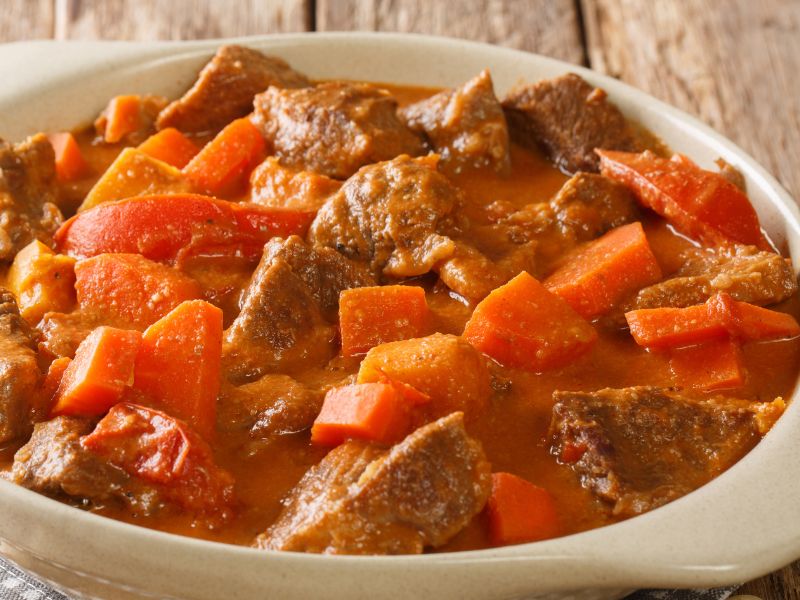
Top Restaurants In Dakar, Senegal
Here’s a broad look at the variety of dining experiences Dakar has to offer, reflecting its vibrant food culture.
1. La Fourchette
Ambiance and Specialty: A fusion of French cuisine with Senegalese ingredients, La Fourchette is renowned for its elegant setting and innovative dishes. It’s a favorite for both locals and tourists seeking a fine dining experience.
2. Chez Loutcha
Ambiance and Specialty: Offering a more traditional dining experience, Chez Loutcha is beloved for its authentic Senegalese and Cape Verdean dishes. The restaurant is a go-to place for trying national dishes like Thieboudienne and Yassa in a cozy, welcoming environment.
3. Le Ngor
Ambiance and Specialty: Situated right by the sea, Le Ngor offers stunning views and specializes in seafood. It’s the perfect spot for a relaxed meal enjoying the ocean breeze and sampling fresh catches of the day, grilled to perfection.
4. Alkimia Restaurant & Bar
Ambiance and Specialty: A modern eatery offering a mix of Mediterranean and Senegalese cuisines, Alkimia is known for its stylish décor and creative cocktails. The menu is a testament to Dakar’s cosmopolitan flair, featuring everything from tapas to gourmet burgers.
5. Lagon 1
Ambiance and Specialty: With a terrace overlooking the Atlantic Ocean, Lagon 1 serves a variety of French-inspired seafood dishes in an unforgettable setting. The restaurant is ideal for romantic dinners or special occasions, where the ambiance is as important as the cuisine.
6. Dakar’s Street Food Stalls
Ambiance and Specialty: For an authentic taste of Dakar’s vibrant street food scene, visit the stalls around Marché Kermel and Plateau. Here, you can enjoy dishes like Dibi (grilled meat) and Accara (black-eyed pea fritters), showcasing the heart and soul of Senegalese cuisine.
7. Terrou-Bi
Ambiance and Specialty: This upscale beach resort and casino also boasts several restaurants with a range of dining options, from buffet-style to à la carte menus featuring international and local cuisines. Dining with panoramic sea views adds to the experience.
8. Le Djoloff
Ambiance and Specialty: A boutique hotel’s restaurant, Le Djoloff offers a menu that creatively combines French techniques with Senegalese flavors. The rooftop setting provides a great ambiance for enjoying Dakar’s evenings.
9. Sunugal Village-Auberge
Ambiance and Specialty: Nestled on the Ngor Island’s edge, Sunugal offers a tranquil escape with its lush garden setting and specializes in traditional Senegalese dishes. It’s a great spot for those looking to enjoy local flavors in a peaceful, scenic environment.
10. Café de Rome
Ambiance and Specialty: Located in the heart of Dakar, Café de Rome is known for its bustling atmosphere and diverse menu, offering everything from Italian pasta to Senegalese specialties. It’s a popular meeting spot for both business lunches and casual dining.
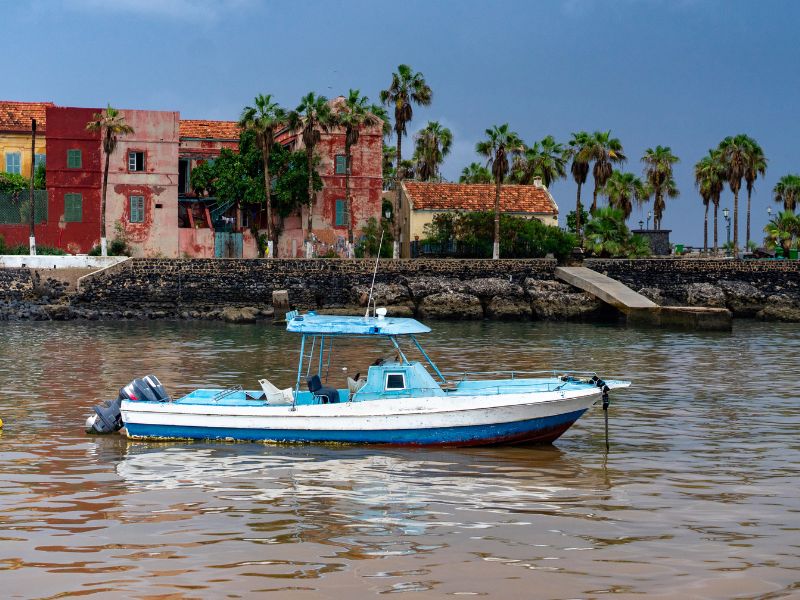
Tours For Visitors To Dakar, Senegal
From historical tours to culinary adventures, here’s a comprehensive list of tours that promise to enrich your visit to Dakar.
1. Historical Tour of Gorée Island
Discover the poignant history of Gorée Island, a UNESCO World Heritage site known for its role in the transatlantic slave trade. This tour offers insights into the island’s past, including visits to the House of Slaves and the Gorée Island Museum, providing a deeper understanding of Senegal’s history and the resilience of its people.
2. Dakar City Tour
Explore the vibrant streets of Dakar on a city tour that takes you through its bustling markets, colonial-era buildings, and notable landmarks like the African Renaissance Monument. Learn about Dakar’s history, culture, and modern-day life from a local guide who brings the city’s stories to life.
3. Culinary and Market Tour
Immerse yourself in Senegal’s rich culinary traditions with a tour of Dakar’s markets followed by a cooking class. Discover local ingredients, spices, and cooking techniques, and then enjoy the fruits of your labor with a meal you’ve helped prepare, offering a taste of authentic Senegalese cuisine.
4. Lac Rose (Pink Lake) Tour
Venture just outside Dakar to witness the natural wonder of Lac Rose, known for its striking pink hues caused by high salt content and algae. This tour allows for swimming in the lake’s therapeutic waters, exploring the nearby salt mounds, and learning about the local salt harvesting industry.
5. Art and Culture Walk
Dakar is a hub for African art and culture, and this walking tour showcases the city’s vibrant art scene, including street art, galleries, and artisan workshops. Meet local artists, learn about Senegalese art forms, and discover the creative spirit that permeates Dakar.
6. Ngor Island Excursion
Escape to the tranquil Ngor Island, a short pirogue (traditional canoe) ride from Dakar. This tour offers relaxation on pristine beaches, opportunities for surfing and snorkeling, and a chance to explore the small yet vibrant island community.
7. Bird Watching in the Technopole
The Technopole area, a wetland near Dakar, is a haven for bird enthusiasts. Guided tours provide opportunities to spot various bird species, including flamingos and pelicans, making for a peaceful day spent in nature’s embrace.
8. Fishing Village Tour
Visit traditional Senegalese fishing villages along the coast to learn about local fishing techniques, the importance of fishing to Senegal’s economy, and daily life in these close-knit communities. Tours may include Kayar, Yoff, or Soumbédioune, offering insights into a vital aspect of Senegalese culture.
9. Sandaga Market Shopping Experience
Dive into the heart of Dakar’s commerce with a guided tour of the Sandaga Market, where you can haggle over goods ranging from textiles to artisan crafts. A local guide will help you navigate the bustling market and share tips on finding the best souvenirs.
10. Dakar Nightlife and Music Tour
Experience Dakar’s legendary nightlife and music scene with a tour that takes you to live music venues and nightclubs. Discover Mbalax, Senegal’s popular music genre, and enjoy performances that showcase the country’s musical diversity and talent.
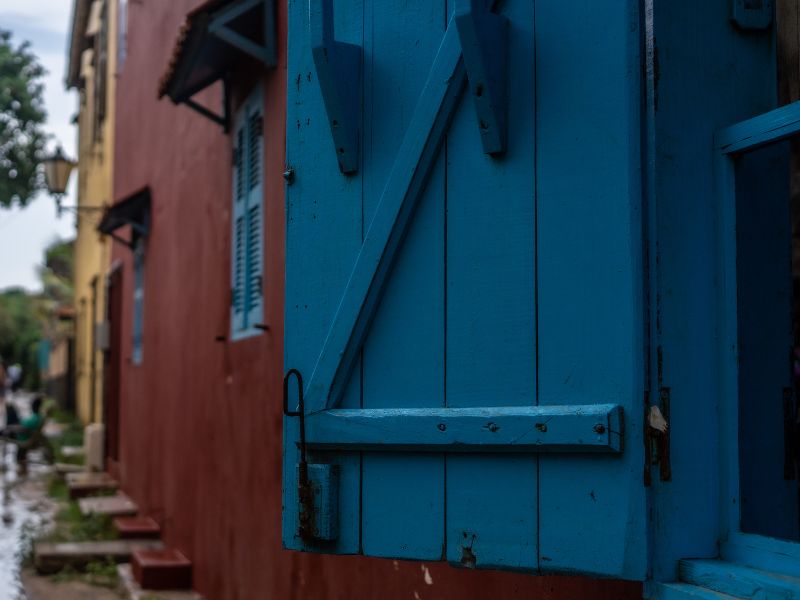
Dakar Accommodations Guide: Hotels, Guesthouses and Hostels
From luxurious hotels with stunning ocean views to cozy guesthouses brimming with local charm, here’s a comprehensive guide to help you find the perfect place to stay in Dakar.
Luxurious Retreats
1. Terrou-Bi Beach & Casino Resort
Offering panoramic views of the Atlantic Ocean, Terrou-Bi is a haven of luxury. Guests can enjoy a private beach, an outdoor pool, several on-site restaurants serving international cuisine, and a vibrant casino for evening entertainment.
2. Radisson Blu Hotel, Dakar Sea Plaza
Situated on the Cape Verde Peninsula, this hotel boasts stylish rooms with breathtaking sea views, a world-class spa, and an infinity pool. The Radisson Blu is ideal for those seeking a blend of modern luxury and serenity.
Mid-Range Comfort
3. Hotel Le Djoloff
A boutique hotel that combines comfort with culture, Le Djoloff offers rooms decorated with African art and textiles. With a rooftop terrace that provides stunning city views and a restaurant serving delicious Senegalese cuisine, it’s a gem in the Fann Hock neighborhood.
4. La Demeure
Nestled in the residential area of Les Almadies, La Demeure is a charming guesthouse known for its warm hospitality and tranquil garden. It’s an excellent choice for travelers looking for a quiet retreat with easy access to Dakar’s attractions.
Budget-Friendly Stays
5. Ker Jahkarlo
A favorite among backpackers, Ker Jahkarlo offers a friendly, communal atmosphere with both private rooms and dormitories. It’s not only a place to sleep but also a cultural exchange, offering cooking classes, live music nights, and language lessons.
6. Via Via Dakar
This hostel is part of a global network that emphasizes cultural experiences and sustainable travel. Located in the bustling Yoff neighborhood, Via Via provides budget accommodations, a vibrant café, and a cultural event space.
Unique and Boutique
7. Casa Mara Dakar
A boutique guesthouse located in the Dakar-Plateau district, Casa Mara charms with its eclectic decor, outdoor swimming pool, and lush garden. It offers a peaceful oasis amidst the hustle and bustle of the city.
8. The Djiby’s
Situated in the Mermoz district, The Djiby’s is a boutique hotel that stands out for its contemporary design inspired by Senegalese traditions. Guests can enjoy a rooftop terrace and an art gallery, making it a stylish choice for art lovers.
Seaside Escapes
9. Les Alizés Beach Resort
Located in the scenic Cap Skirring area, though a bit of a journey from Dakar, Les Alizés offers beachfront accommodations with thatched-roof bungalows, an outdoor pool, and a restaurant that specializes in seafood caught directly from the Atlantic.
10. Ocean & Savana Hotel
Overlooking the tranquil waters of the Dakar Peninsula, this hotel offers comfortable rooms, a seaside restaurant, and easy access to water sports and beach activities. It’s perfect for travelers seeking a beach getaway within reach of Dakar’s city life.
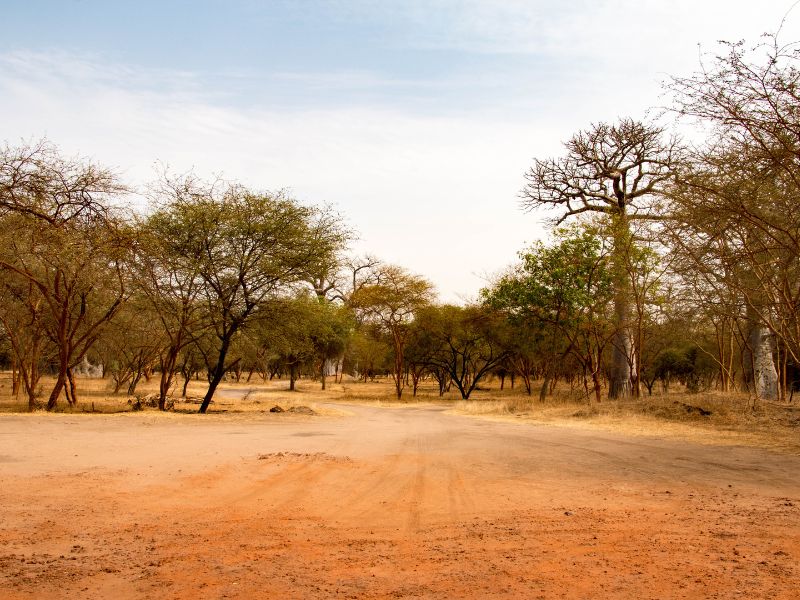
Day Trips From Dakar, Senegal
Whether you’re drawn to the allure of natural wonders or the echoes of history that shape the region, there’s a day trip awaiting every traveler’s curiosity.
1. Gorée Island
A short ferry ride from Dakar, Gorée Island stands as a poignant reminder of the Atlantic slave trade. Its colorful colonial buildings and calm streets contrast sharply with its somber history, highlighted by the House of Slaves. The island also offers art galleries, cafes, and stunning ocean views, making it a complex but essential visit. Gorée is not just a trip through history; it’s a journey through collective memory and resilience.
2. Pink Lake (Lac Rose)
Lac Rose, famed for its striking pink hue due to its high salt content and algae, is a marvel just an hour away from Dakar. Visitors can tour the lake, visit the salt harvesters, and even float effortlessly in its waters. The surrounding area offers quad biking and camel riding for adventure enthusiasts. The contrast of the pink waters against the white salt and blue sky makes for unforgettable sights and photos.
3. Bandia Wildlife Reserve
Bandia Reserve brings you face-to-face with Africa’s majestic wildlife just an hour from Dakar. On a safari drive, you can spot giraffes, rhinos, zebras, and a variety of antelopes in their natural habitat. The reserve also features a baobab burial site, adding a cultural dimension to the natural experience. It’s a perfect escape into the wild for families and nature lovers.
4. Joal-Fadiouth
This unique excursion leads to Joal-Fadiouth, where Joal lies on the mainland and Fadiouth, an island made entirely of shells, is connected by a wooden bridge. Fadiouth, with its shell-covered streets, granaries on stilts, and mixed Christian-Muslim heritage, offers a fascinating insight into Senegal’s religious coexistence. The island’s serene cemetery, also made of shells, overlooks the mangroves. This trip is a testament to the country’s cultural diversity and unity.
5. Saint-Louis
A bit further afield, the historic city of Saint-Louis, a UNESCO World Heritage site, is a journey back in time with its preserved colonial architecture and vibrant arts scene. Once the capital of French West Africa, its charm lies in its faded grandeur and bustling fishing community. The city is also the gateway to the Senegal River delta, rich in birdlife. Saint-Louis combines natural beauty, history, and culture, making it worth the longer trip.
6. Somone Lagoon Reserve
The tranquil Somone Lagoon Reserve is an avian paradise, offering serene landscapes and a rich ecosystem of mangroves. A canoe trip through the lagoon reveals a diverse array of bird species, including flamingos and pelicans. The reserve is also home to small, secluded beaches where visitors can relax. It’s an ideal spot for those seeking peace and natural beauty.
7. Niokolo-Koba National Park
For the ultimate adventure, a trip to Niokolo-Koba National Park, though requiring an overnight stay, showcases Senegal’s diverse ecosystems, including savannahs, forests, and rivers, and is home to elephants, lions, and leopards. The Gambia River running through it offers spectacular landscapes and wildlife viewing opportunities. This UNESCO World Heritage site is a testament to West Africa’s untouched wilderness. It’s a must-visit for avid nature and wildlife enthusiasts.
8. Thies
An hour’s drive takes you to Thies, known for its tapestry and textile factories. The city’s craft markets offer a glimpse into Senegal’s artistic traditions, making it a great place for picking up souvenirs. Thies also serves as a cultural center with its railway museum reflecting the colonial era. It’s a journey into the heart of Senegal’s craftsmanship and industrial heritage.
9. Saloum Delta National Park
A day trip to Saloum Delta National Park immerses visitors in a landscape where water and land intertwine, creating a haven for birds, fish, and shellfish. Traditional pirogue tours guide you through the delta’s islands and mangroves. The park’s biodiversity and the traditional Serer culture make it a profound experience. It’s an exploration of the delicate balance between nature and human life.
10. Mbour
The bustling fishing town of Mbour offers an authentic look into Senegal’s fishing industry with its lively fish market. Just south of Dakar, Mbour also boasts beautiful beaches that are less crowded than those in the capital. The town is known for its craftsmanship, especially woodwork and basket weaving. Mbour provides a taste of Senegalese daily life, from the thrum of its markets to the serene beach sunsets.

Dakar Transportation Guide
Here’s your complete travel guide to getting around Dakar, from public transport to more personalized travel methods.
Public Buses
Dakar’s public bus system, operated by Dakar Dem Dikk, serves the city and its suburbs with a network of routes covering major areas and attractions. Buses are an affordable way to travel, though they can be crowded during peak hours. Look for bus stops marked with the Dakar Dem Dikk sign, and be prepared for an authentic Dakar experience.
Car Rapides
Iconic to Dakar, Car Rapides are brightly painted minibuses that operate on fixed routes throughout the city. They’re fast, frequent, and offer a cheap way to get around, though they might not be the most comfortable option for everyone. Signal the driver to stop, and pay the fare to the apprentice (usually found hanging from the bus’s rear).
Taxis
Taxis are plentiful in Dakar and can be hailed on the street. They’re metered, but it’s common practice to negotiate the fare before starting your journey. Yellow and black in color, taxis offer a more comfortable and private way to navigate the city. For late-night travel or longer distances, taxis are a reliable option.
Motorcycle Taxis
For shorter distances or when traffic is heavy, motorcycle taxis are a quick and efficient way to move around. They’re especially useful for navigating narrow streets or areas where larger vehicles might struggle. Always agree on a fare before starting your trip, and be aware that this mode of transport might not be suitable for everyone.
Dakar Ter (Commuter Train)
The Dakar Ter, a relatively new addition to the city’s transport network, offers a modern and efficient way to travel between Dakar and Diamniadio. With air-conditioned carriages and regular service schedules, it’s a comfortable option for avoiding traffic congestion. The train stations are well-equipped and provide an alternative view of Dakar’s surroundings.
Ferries
To visit places like Gorée Island, ferries depart regularly from the Port of Dakar. The ferry service is reliable and provides a scenic journey across Dakar’s bay. Tickets can be purchased at the port, and it’s advisable to check the schedule in advance, especially during tourist season.
Car Rental
For those preferring to explore at their own pace, car rental agencies are available in Dakar, offering various vehicles to suit different needs. Driving in Dakar can be challenging due to traffic congestion and different driving norms, so this option is best suited for confident drivers. Ensure you have a valid international driver’s license.
Bicycles and Scooters
Renting a bicycle or a scooter can be an enjoyable way to explore Dakar’s neighborhoods, particularly in less congested areas or along the Corniche. Some hotels and rental shops offer bikes and electric scooters, though it’s important to stay aware of your surroundings and traffic rules.
Walking
In areas like Plateau (the city center) or along the Corniche, walking can be a pleasant way to take in the sights and sounds of Dakar. Many of Dakar’s attractions are within walking distance of each other in these areas, making walking a viable option for short distances.

Where To Visit After Your Trip To Dakar?
Here’s a list of places to visit after Dakar, promising a continuation of your West African journey.
1. Saint-Louis, Senegal
Once the capital of French West Africa, Saint-Louis charms with its colonial architecture and vibrant arts scene. Nestled at the mouth of the Senegal River, the city is a UNESCO World Heritage site, known for its annual jazz festival. Visitors can explore the bustling fish market, navigate the river’s mangroves, and enjoy the serene beaches. Saint-Louis serves as a cultural bridge between the past and present.
2. Lompoul Desert, Senegal
Experience the Sahara in miniature at the Lompoul Desert with its golden dunes and vast open skies. Visitors can enjoy camel rides, spend the night in traditional Mauritanian tents, and savor the tranquility of the desert under a canopy of stars. The desert’s unexpected presence in Senegal’s diverse landscape offers a memorable adventure. It’s a striking contrast to Dakar’s coastal vibrancy.
3. Sine-Saloum Delta, Senegal
A UNESCO World Heritage site, the Sine-Saloum Delta is a maze of mangroves, islands, and waterways teeming with birdlife. This area is perfect for eco-tourists and those looking to explore Senegal’s natural beauty through boating, fishing, and bird watching. The delta also offers insight into Serer culture and traditional shellfish harvesting methods. Its peaceful atmosphere is a soothing retreat from city life.
4. Bandia Wildlife Reserve, Senegal
Just a short drive from Dakar, Bandia Wildlife Reserve offers the chance to see Africa’s majestic wildlife up close, including giraffes, rhinos, and various antelope species. Safari tours provide educational insights into Senegal’s efforts to conserve its wildlife and habitats. The reserve is an accessible slice of the savannah, ideal for families and nature enthusiasts. It’s a reminder of the continent’s rich biodiversity.
5. Casamance Region, Senegal
Known for its lush landscapes and distinct Jola culture, the Casamance region offers a different pace of life compared to northern Senegal. Visitors can explore vibrant local markets, serene beaches, and the sacred forests scattered throughout the area. The region’s rich cultural tapestry and welcoming communities provide a deep dive into Senegal’s diverse cultural heritage. It’s a journey into the heart of Senegal’s soul.
6. Fathala Wildlife Reserve, Senegal
Near the Gambian border, Fathala Wildlife Reserve allows visitors to walk with lions, a unique experience in West Africa. The reserve also shelters indigenous and reintroduced species, such as rhinos and giant eland. Guided safaris and luxury tent accommodations offer an immersive nature experience. It’s a conservation-led adventure that brings you face-to-face with Africa’s majestic beasts.
7. Kafountine and Abéné, Senegal
For a taste of Senegal’s Atlantic Coast, head to the laid-back villages of Kafountine and Abéné, famous for their music festivals and pristine beaches. These communities are a haven for drumming, dance, and cultural exchange. The area’s relaxed vibe, combined with the rhythmic beat of traditional music, creates a perfect setting for cultural immersion. It’s where the spirit of Senegal’s music scene comes alive.
8. The Gambia
Crossing into The Gambia offers a different perspective on West Africa, centered around the Gambia River. The country is famed for its birdwatching opportunities, friendly villages, and Kunta Kinteh Island, a critical site in the history of the slave trade. Banjul, the capital, provides a mix of markets, museums, and beaches. It’s a seamless blend of natural beauty and cultural depth.
9. Mbour and the Petite Côte, Senegal
Mbour and the surrounding Petite Côte area are known for their fishing communities, vibrant markets, and peaceful beaches. A visit here offers insights into Senegal’s fishing industry and the opportunity to relax by the sea or engage in water sports. The area is also a gateway to the Bandia and Fathala reserves, making it a hub for exploring Senegal’s natural wonders. It’s where tradition meets the tranquility of coastal life.
10. Saloum Delta National Park, Senegal
Further exploration of the Sine-Saloum Delta can lead you to the National Park, where the biodiversity intensifies. Guided canoe trips through the mangroves reveal hidden lagoons, bird colonies, and ancient shell mounds. The park’s eco-lodges offer sustainable accommodations that immerse visitors in the delta’s serene beauty. It’s an eco-adventure that showcases the delicate balance between humans and nature.
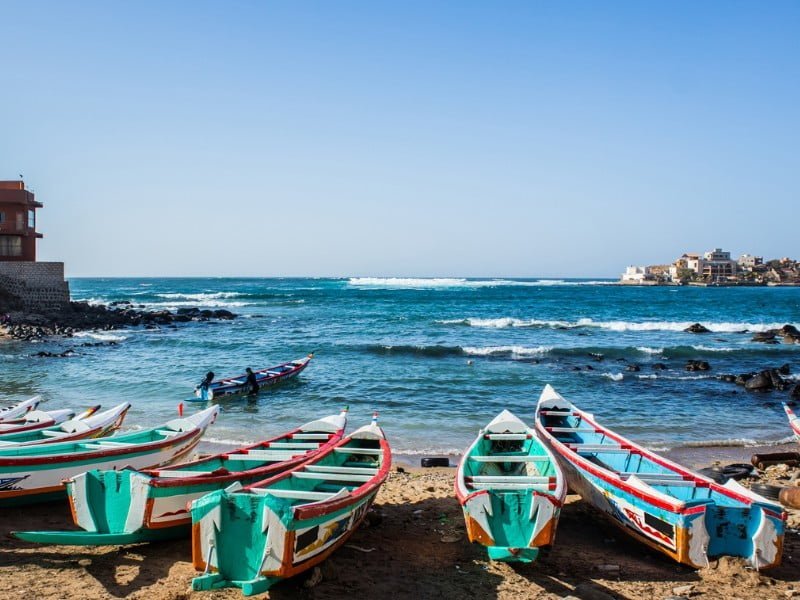
Dakar Travel Questions Answered: Practical Tips, Local-Style Advice, Safety & Planning Tips
How many days do you really need in Dakar for a first-time visit?
It depends. If you just want a feel for the city – Gorée Island, the African Renaissance Monument, a market or two, and a stroll along the Corniche – you can squeeze a lot into 2 full days and 2–3 nights. If you’d like to mix in a beach escape to N’Gor, a museum or two, and maybe a half-day out to Lac Rose or Bandia Reserve, I’d aim for 3–4 full days. Dakar is also a great base for day trips to places like Saint-Louis or Saly, so if you’re combining city time with excursions, 5–6 days starts to feel like a sweet spot.
What is the best time of year to visit Dakar in terms of weather?
Generally, the best time is the dry, slightly cooler stretch from about November to April. Dakar has a semi-arid coastal climate with a distinct rainy season roughly from July to October, when heavy but often short downpours can hit and humidity spikes. The rest of the year is drier, with daytime highs usually in the mid-20s to low-30s °C and cooler, breezy evenings thanks to the Atlantic. If you’re heat-sensitive and hate sticky humidity, avoid late August and September and lean toward December–March.
Is Dakar safe for solo travelers, including at night?
Mostly, yes – with caveats. Dakar is one of the more stable and welcoming capitals in West Africa, and violent crime against tourists is relatively rare, but petty theft is a real thing, especially in crowded markets, on buses, and around busy nightlife zones. Use the usual big-city precautions: keep valuables zipped and close to your body, avoid flashing your phone and camera in hectic crowds, and take registered taxis or ride-hail at night instead of walking long distances in the dark. In my experience, people are incredibly friendly, but you still want to exercise big-city street smarts.
Which Dakar neighborhood is best to stay in for first-time visitors?
It depends on your vibe. Plateau (the city center) is great if you want to be close to museums, markets, colonial architecture, and the port for Gorée Island, and you’re okay with a more urban feel. Almadies and Les Mamelles have a more upscale, expat-friendly atmosphere with seaside restaurants, bars, and easier access to the Corniche. Ngor and Yoff feel more laid-back and beachy, popular with surfers and long-stay travelers. For a first-timer, Plateau plus either Almadies or Ngor makes a nice combo: culture and history by day, sea breezes and sunsets in the evening.
How do I get from Dakar Blaise Diagne International Airport to the city?
The airport sits well outside central Dakar, so you have a few options. The most comfortable is a private transfer or hotel pickup, which you can pre-book and pay a fixed rate for. Regular taxis are cheaper but you’ll want to agree the fare clearly before you get in. There’s also the TER (Train Express Régional), a modern commuter train that connects the airport area (AIBD) with stations closer to Dakar, which can help you dodge some of the notorious traffic; from the station, you’d then hop in a taxi to your hotel. If you’re arriving late at night or with lots of luggage, I’d keep it simple and go with a pre-arranged transfer or reputable taxi.
What’s the easiest way to visit Gorée Island, and how much time should I allow?
Absolutely go. Ferries to Gorée Island depart from the port in Plateau and the crossing takes around 20–30 minutes each way on a passenger boat. Ferries usually run multiple times a day, but schedules can change, so it’s worth double-checking at the terminal or via your accommodation. I’d allow at least half a day: that gives you time to tour the House of Slaves, wander the quiet, car-free lanes, pop into a couple of small museums and galleries, and have lunch with a sea view before heading back. If you’re a history buff or keen photographer, plan a full day and catch a later ferry back.
How do you actually get around Dakar without losing your mind in traffic?
Slowly! Traffic in Dakar can be intense, especially at rush hour. For most visitors, yellow-and-black taxis are the default: they’re everywhere, relatively cheap, and you simply negotiate the price before hopping in. Car rapides (the colorful minibuses) are fantastic to look at but chaotic and not very intuitive for first-timers. The new TER train is handy for longer hops between the city and the suburbs or airport corridor, and ferries are your go-to for places like Gorée and N’Gor. For short distances in Plateau or along parts of the Corniche, I like to walk – it’s often quicker than sitting in a jam and you actually see the city.
Is Dakar an expensive city to visit compared with other places in Africa?
Dakar isn’t a strict-budget paradise, but it doesn’t have to be wallet-crushing either. Mid-range travelers can expect prices similar to a medium European city: decent hotels, sit-down restaurant meals, and taxis all add up. Street food, local eateries, and markets are where you’ll save a lot – a plate of thieboudienne or yassa in a local joint is very good value. Imported alcohol, Western-style cafés, and high-end restaurants can be pricey. Backpackers who are willing to stay in guesthouses or hostels, eat local, and use shared taxis or buses can keep daily costs reasonable.
What are some common scams or hassles I should watch out for in Dakar?
Nothing wildly unusual, but a few patterns pop up. Around major sights and markets, you may meet “helpers” who insist on guiding you, then demand a tip or high “fee” after the fact, so be clear if you don’t want a guide. In crowded markets and on public transport, pickpockets target phones and wallets, so keep bags zipped and in front of you. Taxi drivers sometimes quote inflated prices to tourists; ask your hotel for a ballpark fare first and negotiate firmly but politely. You may also meet very persistent vendors, especially around popular viewpoints – a smile, a “no thank you,” and walking on usually does the trick.
Is Dakar a good destination for families or kids?
Yes. Families often do really well in Dakar because the city naturally offers a mix of outdoor time, beaches, boat rides, wildlife day trips, and hands-on cultural experiences. Gorée Island, N’Gor Beach, Bandia Reserve, and Lac Rose all tend to land well with kids. The main things to watch are sun exposure, hydration, and pacing – the midday heat can zap little ones quickly – plus being extra cautious with food hygiene and water. If you’re traveling with very young kids, I’d lean toward staying in neighborhoods with quieter streets and easy beach access, like Almadies or Ngor.
What should I wear in Dakar, and how conservative is it?
Comfortable and respectful is the sweet spot. Dakar is majority Muslim but also quite cosmopolitan, so you’ll see everything from traditional boubous to jeans and T-shirts. As a visitor, light, breathable clothing that covers shoulders and at least to the knee is ideal for wandering markets, visiting mosques, and riding public transport. On the beaches and on N’Gor you’ll see regular swimwear, but very revealing outfits away from the water can feel out of place. A light scarf is handy for sun, wind, and the odd situation where you might want a bit more coverage.
Can you drink the tap water in Dakar, and how careful do I need to be with food?
Not really. Most visitors stick to bottled or filtered water to avoid stomach issues; it’s widely sold and inexpensive. For food, I’m generally happy eating in busy local eateries where there’s good turnover, as well as street food stands that are clearly cooking fresh and hot in front of you. As usual, be more cautious with raw salads, ice, and anything that’s been sitting out in the sun. Packing basic meds for mild stomach upsets is smart, but with sensible choices you can enjoy Dakar’s food scene without spending your holiday in the bathroom.
Is Dakar a good base for day trips and short getaways?
Absolutely. One of Dakar’s big strengths is how many contrasting experiences you can reach in just an hour or two. Gorée Island gives you that deep historical and emotional hit; Lac Rose brings the surreal pink water and salt dunes; Bandia and Fathala reserves offer safari-style wildlife viewing; Saly and the Petite Côte give you classic beach-resort downtime; and Saint-Louis or the Sine-Saloum Delta work as longer but very rewarding side trips. If you don’t want to think about logistics, there are plenty of local agencies offering packaged day tours from Dakar.
Is Dakar walkable, or do I need taxis for everything?
A bit of both. Plateau and parts of the Corniche are happily walkable, and wandering on foot is one of the best ways to soak up street life, architecture, and coastal views. That said, Dakar sprawls, and many neighborhoods are separated by long, busy roads that aren’t pleasant to walk along, especially in the midday sun. I usually plan my day in clusters: pick one or two areas to walk within, then use taxis to jump between them. Good walking shoes or sandals are essential; broken pavement and sand patches are common.
What’s the deal with N’Gor Island – is it worth the boat ride?
Yes. N’Gor Island is one of my favorite easy escapes from the city. A short pirogue ride from the mainland takes you to a small island with a mellow village, beaches on both the surfy and sheltered sides, beach bars, and a very relaxed pace. Surfers head for the Atlantic-facing side, while swimmers and families tend to favor the calmer beaches. It’s a great spot for a half-day or full day of swimming, sunning, and long, lazy lunches, and it gives you a completely different feel from central Dakar with almost no travel hassle.
Are there any cultural norms or etiquette tips I should know before visiting Dakar?
Absolutely. A few basics go a long way here. Greetings matter, so take a moment to say hello and ask how someone is before diving into questions or negotiations. Using your right hand to give or receive money and objects is considered more polite. Dress modestly in non-touristy areas and around religious sites, and always ask before photographing people, especially in markets or villages. Tipping is appreciated but not usually over the top – rounding up or adding 5–10% in restaurants is common. Above all, patience and a sense of humor are gold when schedules slip or plans change, which they often do in Dakar.
Dakar Travel Guide: Final Thoughts
As our journey through Dakar comes to a close, it’s hard not to feel a bit wistful. This city, with its pulsating heart and soulful rhythm, has a way of leaving an indelible mark on those who wander its vibrant streets. Let’s take a moment to wrap up our adventure and reflect on why Dakar deserves a special place on every traveler’s map.
The Soul of Senegal
Dakar is more than Senegal’s capital; it’s the soul of the country. A place where ancient traditions blend seamlessly with the push towards the future. From the haunting beauty of Gorée Island to the bustling markets filled with Senegalese crafts and fabrics, Dakar offers a journey through time that’s both enriching and humbling.
A Feast for the Senses
The culinary adventures in Dakar are a delight to the senses. Each dish tells a story of the land, the sea, and the people who call this place home. Whether it’s the fiery bite of a freshly prepared Yassa or the comforting embrace of a bowl of Thieboudienne, Dakar’s cuisine is a direct route to understanding the heart of Senegalese culture.
An Artistic Haven
Dakar’s streets are alive with art, from the vibrant murals that adorn city walls to the rhythmic beats of Mbalax that soundtrack the night. The city’s galleries and music venues offer a glimpse into the soul of Dakar, showcasing the creativity and resilience of its people. It’s a place where art isn’t just observed; it’s felt, lived, and breathed.
Embracing the Adventure
For the intrepid traveler, Dakar is a gateway to adventure. The pink waters of Lac Rose, the wildlife of Bandia, and the serene beauty of the Sine-Saloum Delta are just a day trip away, offering a taste of Senegal’s stunning natural diversity. Dakar is a launchpad for explorations that can transform the way you see the world.
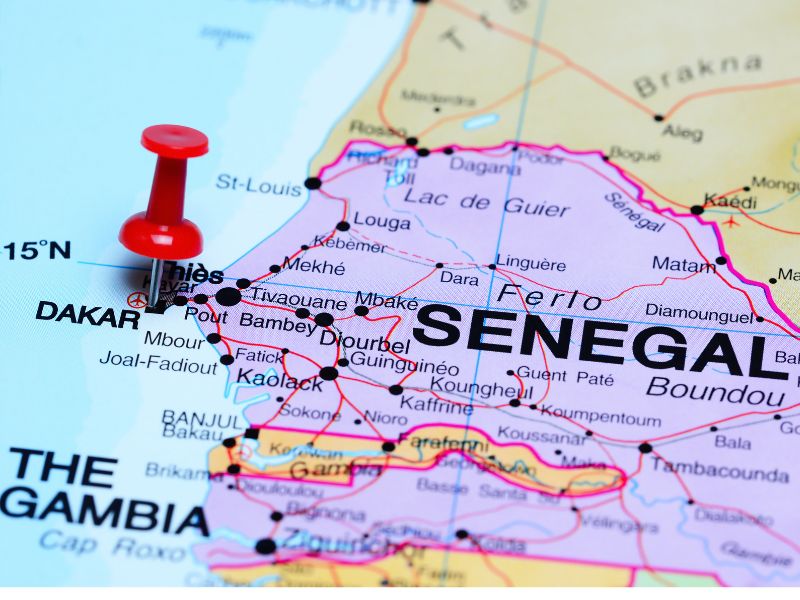
Ode To Dakar
In Dakar’s vibrant streets, a traveler roams, Where culture and history find their homes. From bustling markets to shores of the sea, A city alive with rhythm and glee.
Goree Island whispers tales of the past, Where echoes of slavery still forever last. But amidst the pain, hope rises high, Through art, music, and the people’s cry.
Plateau’s grandeur in colonial grace, Preserves the stories time can’t erase. The Presidential Palace stands tall and proud, As history weaves its intricate shroud.
The African Renaissance Monument so grand, Symbolizes strength across the land. With outstretched arms embracing the sky, It speaks of unity, reaching ever high.
Lac Rose’s pink hues mesmerize the eye, A natural wonder, a spectacle nearby. And on N’Gor Island’s sandy shore, Relax and let the ocean’s rhythm restore.
Senegalese flavors dance on the tongue, Thieboudienne, yassa, songs yet unsung. Indulge in the spice, the richness and zest, Savor the feast, an epicurean quest.
Music fills the air, beats pulse through the night, From mbalax rhythms to djembe’s delight. Let your feet move to the joyful sound, As Dakar’s soul makes your spirit unbound.
In Dakar, a tapestry of cultures weaves, From Wolof traditions to tales it conceives. With warmth and smiles, the people embrace, Inviting you to their vibrant embrace.
So wander through Dakar, let your spirit roam, Discover its treasures, make this city your home. For in its heart, a traveler finds delight, In Dakar’s embrace, an unforgettable flight.
